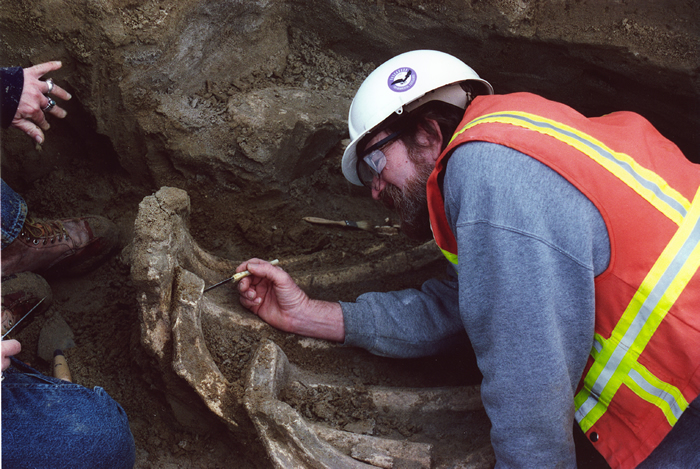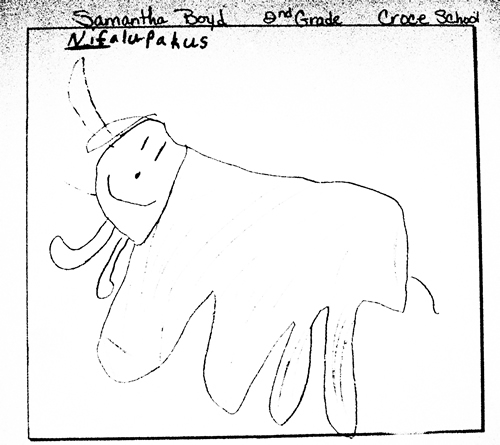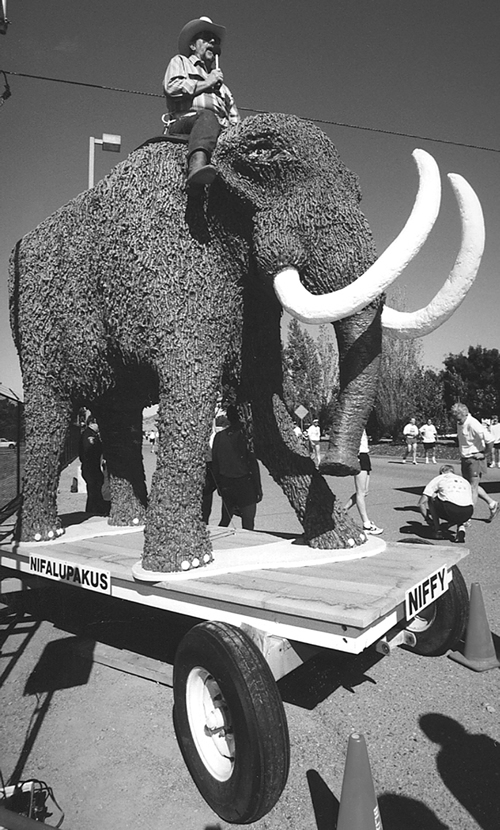Looking Back on a Mammoth Discovery
December 26, 2018
In December 1997, workers at the NIF construction site were surprised with an early holiday gift. While removing 210,000 cubic yards of earth—enough to fill 2½ Olympic-size swimming pools—for a utility trench some 30 feet below ground level, they unearthed the bones of a prehistoric mammoth. The remains included a partial skull, jawbone, vertebrae, and a tusk.
 Paleontologist C. Bruce Hanson excavates the mammoth bones in 1998. Credit: LLNL archives.
Paleontologist C. Bruce Hanson excavates the mammoth bones in 1998. Credit: LLNL archives. Experts from the University of California were called in, and samples were sent to LLNL’s Center for Mass Spectrometry for analysis and dating. A preliminary investigation by University of California, Berkeley paleontologist Mark Goodwin estimated the bones to be more than 10,000 years old (later dated at 16,000 years old).
Excavation of the bones required expert oversight, and the Lab contracted a team, headed by paleontologist C. Bruce Hanson, to extract the bones for preservation and study. The excavation team worked carefully to expose and clean the mammoth, applying a hardening varnish to seal the cracks and stabilize the bones.
 Second grader Samantha Boyd’s winning drawing for the “Name-the-Mammoth Contest” in 1998.
Second grader Samantha Boyd’s winning drawing for the “Name-the-Mammoth Contest” in 1998. To prepare the mammoth for removal, they wrapped the bones with a layer of moistened tissue paper, followed by strips of burlap dipped into plaster for safe transport to University of California, Berkeley’s Museum of Paleontology. Two weeks after the initial find, another bone cluster was unearthed some 15 feet from the original discovery site—including ribs and an almost complete humerus, or shoulder bone.
According to paleontologists, mammoths were actually quite common to this area; and, as such, the discovery of the bones at the NIF construction site didn’t come as a complete surprise. According to Goodwin, however,the NIF find was significant, as it was a more complete mammoth skeleton than is usually found.
So too, per lead paleontologist C. Bruce Hanson, the ancient mammoth excavated from NIF’s construction site most likely had plenty of company, including at least one other mammal that apparently had made a meal of the mammoth. Tooth marks on the bones suggested to Hanson that a dire wolf or saber-toothed tiger may have killed the ancient mammoth.
The mammoth bones became a part of the permanent collection at the UC Museum of Paleontology in Berkeley.
 Deputy Director for Operations Bob Kuckuck kicks off the Lab’s 1998 Run for Home atop Niffy.
Deputy Director for Operations Bob Kuckuck kicks off the Lab’s 1998 Run for Home atop Niffy. Of course, this wasn’t the first discovery of ancient bones at LLNL. On Oct. 30, 1974, Lab employee Chips McPherson discovered the foreleg of a mastodon, estimated to be 1 million years old, at Site 300 in Tracy, Calif. In that instance, days of heavy rain, rather than construction work, revealed the bone sticking out of a road embankment.
In practical terms, the discovery of the mammoth’s bones caused no real impact to LLNL operations, as NIF construction stayed on schedule throughout the excavation. The discovery, however, generated a great deal of excitement and interest among Lab employees and throughout the local community—making 1998 the year of the mammoth at the Lab.
Tapping into the excitement behind the prehistoric find, the Lab sponsored a local contest in March 1998 for Livermore school children to name the mammoth. The “Name-The-Mammoth Contest” invited elementary children to come up with a name and, depending on grade-level, either draw a picture or write a paragraph extolling the virtues of the selected name.
The grand prize winner was seven-year old Samantha Boyd, who came up with “Nifalupakus,” or “Niffy” for short.
“Niffy,” in manifest plaster form, would go on to feature in several Lab-sponsored events throughout the remainder of the year. To celebrate the City of Livermore’s 80th annual rodeo parade, carpenters within the Plant Engineering Shops donated their time to create a life-sized Niffy replica to feature as a float in the parade. Later that year, Niffy made a further appearance, this time at the Lab’s annual “Run for Home” event, with Deputy Director for Operations Bob Kuckuck perched atop the beast to kick off the race.
—Jeffrey Sahaida
Follow us on Twitter: @lasers_llnl



